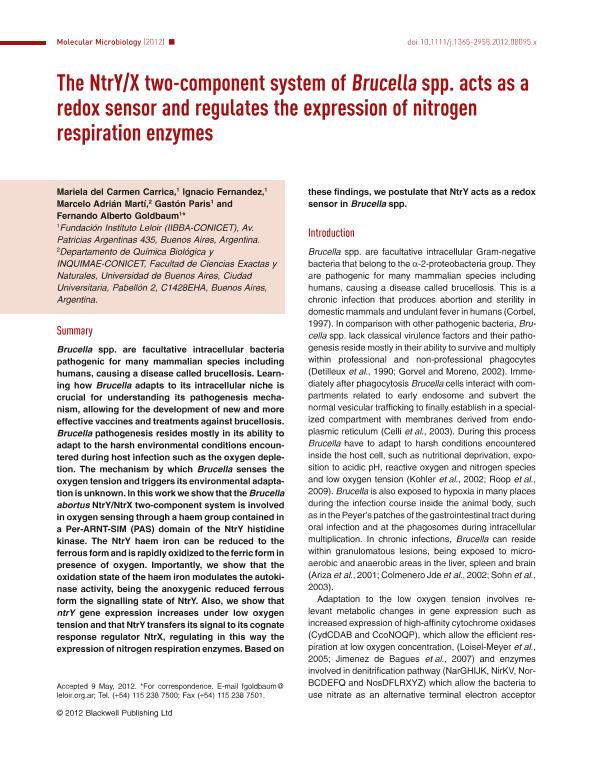Artículo
The NtrY/X two-component system of Brucella spp. acts as a redox sensor and regulates the expression of nitrogen respiration enzymes
Carrica, Mariela del Carmen ; Fernandez, Ignacio
; Fernandez, Ignacio ; Marti, Marcelo Adrian
; Marti, Marcelo Adrian ; Paris, Gastón
; Paris, Gastón ; Goldbaum, Fernando Alberto
; Goldbaum, Fernando Alberto
 ; Fernandez, Ignacio
; Fernandez, Ignacio ; Marti, Marcelo Adrian
; Marti, Marcelo Adrian ; Paris, Gastón
; Paris, Gastón ; Goldbaum, Fernando Alberto
; Goldbaum, Fernando Alberto
Fecha de publicación:
07/2012
Editorial:
Wiley Blackwell Publishing, Inc
Revista:
Molecular Microbiology
ISSN:
0950-382X
Idioma:
Inglés
Tipo de recurso:
Artículo publicado
Clasificación temática:
Resumen
Brucella spp. are facultative intracellular bacteria pathogenic for many mammalian species including humans, causing a disease called brucellosis. Learning how Brucella adapts to its intracellular niche is crucial for understanding its pathogenesis mechanism, allowing for the development of new and more effective vaccines and treatments against brucellosis. Brucella pathogenesis resides mostly in its ability to adapt to the harsh environmental conditions encountered during host infection such as the oxygen depletion. The mechanism by which Brucella senses the oxygen tension and triggers its environmental adaptation is unknown. In this work we show that the Brucella abortus NtrY/NtrX two-component system is involved in oxygen sensing through a haem group contained in a Per-ARNT-SIM (PAS) domain of the NtrY histidine kinase. The NtrY haem iron can be reduced to the ferrous form and is rapidly oxidized to the ferric form in presence of oxygen. Importantly, we show that the oxidation state of the haem iron modulates the autokinase activity, being the anoxygenic reduced ferrous form the signalling state of NtrY. Also, we show that ntrY gene expression increases under low oxygen tension and that NtrY transfers its signal to its cognate response regulator NtrX, regulating in this way the expression of nitrogen respiration enzymes. Based on these findings, we postulate that NtrY acts as a redox sensor in Brucella spp.
Palabras clave:
Brucella
,
redox sensor
,
NtrY
,
virulence
Archivos asociados
Licencia
Identificadores
Colecciones
Articulos(IIBBA)
Articulos de INST.DE INVEST.BIOQUIMICAS DE BS.AS(I)
Articulos de INST.DE INVEST.BIOQUIMICAS DE BS.AS(I)
Articulos(INQUIMAE)
Articulos de INST.D/QUIM FIS D/L MATERIALES MEDIOAMB Y ENERGIA
Articulos de INST.D/QUIM FIS D/L MATERIALES MEDIOAMB Y ENERGIA
Citación
Carrica, Mariela del Carmen; Fernandez, Ignacio; Marti, Marcelo Adrian; Paris, Gastón; Goldbaum, Fernando Alberto; The NtrY/X two-component system of Brucella spp. acts as a redox sensor and regulates the expression of nitrogen respiration enzymes; Wiley Blackwell Publishing, Inc; Molecular Microbiology; 85; 1; 7-2012; 39-50
Compartir
Altmétricas



